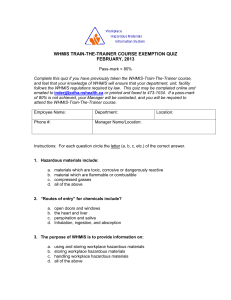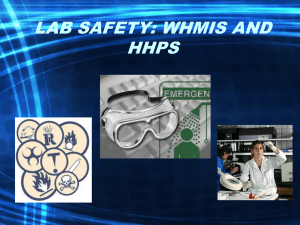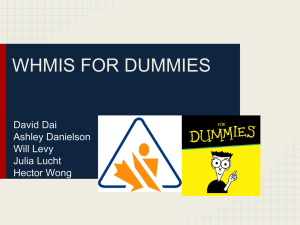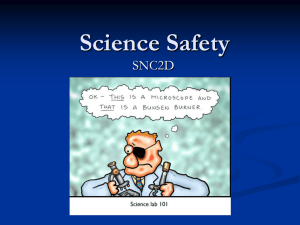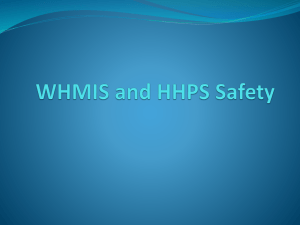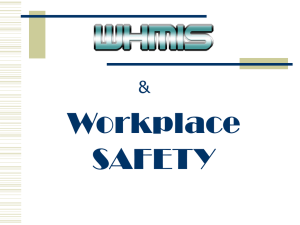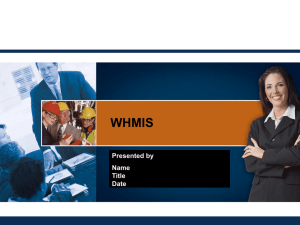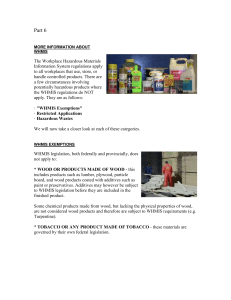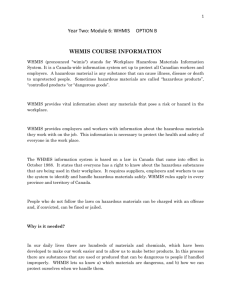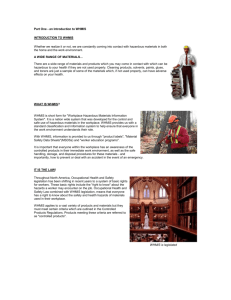WHMIS - Town of Huntsville
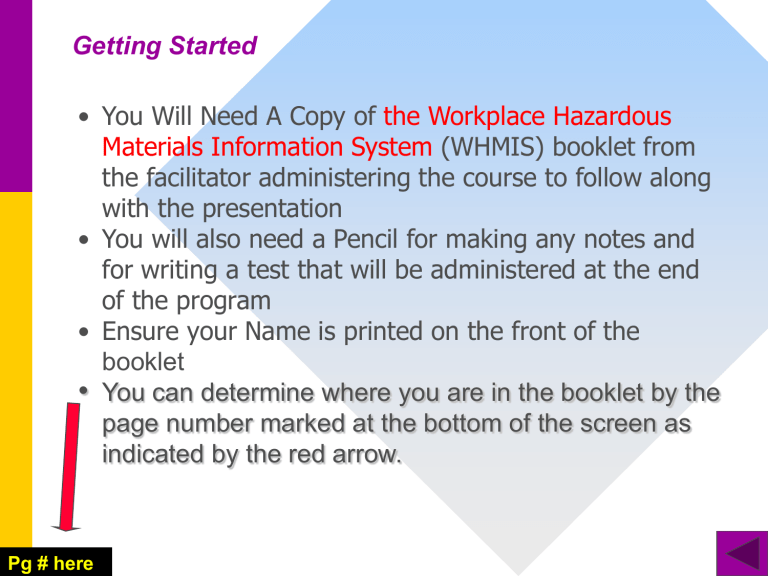
Getting Started….
Getting Started
• You Will Need A Copy of the Workplace Hazardous
Materials Information System (WHMIS) booklet from the facilitator administering the course to follow along with the presentation
• You will also need a Pencil for making any notes and for writing a test that will be administered at the end of the program
• Ensure your Name is printed on the front of the booklet
•
You can determine where you are in the booklet by the page number marked at the bottom of the screen as indicated by the red arrow.
Pg # here
Pg. 1
Getting Started….
Getting Started…
You are about to study the Town of Huntsville’s
W orkplace H azardous M aterials I nformation S ystem
(WHMIS) . It is important for us to know that you have a good understanding on how to control potential hazards with any substances that you could be exposed to in your workplace, so that you remain healthy
If you haven’t already …You will need to click the icon at the bottom of your screen that looks like a projection screen – now – to advance through the session.
To Advance through the program simply tap (do not hold it down) the Keyboard’s Spacebar or click the left mouse button.
Pg. 1
Other Instructions
• The last sentence (or animation) on the slide will be indicated with a period, so that you know that the next time you press the spacebar you will advance to the next slide
• The left facing arrow at the bottom of each slide will reverse the program to the beginning of the previous slide if you need to reverse back, just position your mouse on the arrow and left click the mouse.
The Town of Huntsville presents…
WHMIS
The Workplace Hazardous Materials
Information System
Objectives
• Purpose of the System
• Its The Law - WHMIS Legislation
• Responsibilities of the Employer, Suppliers, the Joint
Health and Safety Committee – AND YOU
• How Hazardous Materials Can Enter our Bodies
• Hazard Symbols
• Labels
• Material Safety Data Sheets.
Pg. 4
Purpose of the Workplace
Hazardous Materials
Information System -
WHMIS
• Provides Information on Hazardous Materials
Used in Workplace
• Provides an Easy Process for Identifying
Hazardous Products.
Ontario Legislation
Pg. 4
•
Details begin next page...
All Workers Have a
“Right to Know”
• Where are these hazardous substances located ?
• How could these hazardous substances harm me ?
• How could they get into my body ?
• How do I protect myself from this potential harm ?
Pg. 4
Responsibilities Under
WHMIS
• Duties of the Supplier of the Material to the Employer
– Classify Product
– Apply Supplier Label
– Provide Material Safety Data Sheet.
Pg. 4
Responsibilities Under
WHMIS
• Duties of the Employer
– Maintain a Workplace Inventory of Hazardous
Substances on site
– Ensure Proper Labeling is Used on all WHMIS
Regulated Products
– Label Piping Systems/Vessels (an example would be a refrigerant pipe in the arena for making ice)
– Maintain and Make Available Material Safety
Data Sheets (MSDS)
– Train Workers.
Pg. 5
Responsibilities Under
WHMIS
• Duties of a Worker
– Participate in Training
– Apply Knowledge and Training.
Pg. 5
Responsibilities Under
WHMIS
• Duties of the Joint Health & Safety
Committee
– Annually Review the WHMIS System to ensure that it meets the needs of the organization.
Pg. 5
Information Delivery
Communication of WHMIS is Achieved By:
• Labels
– Supplier Label
– Workplace Label
• Material Safety Data Sheets (MSDS)
• Worker Education.
Pg. 5
Routes of Entry
How Controlled Substances Enter Your Body
• Inhalation or breathing through your nose and mouth
• Ingestion or swallowing through your mouth and into your stomach
• Absorption or soaking in through your eyes and skin
• Injection by syringe or other blood or body fluid exposure.
Pg. 6
Physical Forms of
Hazardous Materials include...
• Dusts
• Mists
• Fumes
• Vapours
• Gases.
Action of Toxins
Definition : Toxin is a word meaning “Poison”
• Acute Effects – symptoms occur in the short term
• Chronic Effects – symptoms occur on the long term
• Latency Period of Disease - time for disease to manifest or symptom to appear
• Sensitizers - where you become sensitive to a hazardous material over a period of time from your frequency or duration of exposure.
Pg. 6
Dose-Response
Relationship
Pg. 6
• Effect is Directly Related to Dose
• Think about anything you are exposed to – too much sunlight can result in skin cancer, too much alcohol can result in liver disease or too much exposure to a hazardous substance could cause cancer, central nervous system damage, or possibly a simple skin rash.
Pg. 7
WHMIS Hazard Symbols
Hazard Symbols Help Us to Better
Understand the Potential Hazards of
Product – Before We Use It
There are 8 Different Hazard Symbols
Used in the WHMIS System. They Are:
Class
A B C D1 D2 D3 E F
Pg. 6
Compressed
Gas
Flammable
Combustible
Oxidizing
Material
Poisonous &
Infectious
Material
Immediate
Toxic
Effects
Poisonous &
Infectious
Material
Long Term
Toxic
Effects
Poisonous &
Infectious
Material
Biohazard
Corrosive
Material
Dangerously
Reactive
Pg. 6
Class A
• Compressed Gas
– Any Hazardous Material that is contained under pressure including compressed gas, dissolved gas, or liquefied gas.
Compressed Gas Cylinders
• store and transport with safety cap
• comply with storage restrictions
Not Properly Secured
• DO NOT store fuel gas with oxygen
• secure in an upright position
• use in a well ventilated area
• use the proper type of regulator and know its history.
Pg. 7
Pg. 7
Class B
• Flammable and Combustible Material
– Flammable Gases
– Flammable and Combustible Liquids
– Flammable Solids
– Flammable Aerosols
– Reactive Flammable Material.
Pg. 7
Flammable Materials
Some products are more flammable than others and require special consideration Products like:
• Methanol, Toluene, Butane,
Ethanol
• Store liquids in Flammable Storage
Cabinet
• NEVER store with oxidizers
• Keep away from heat, ignition sources, and direct sunlight
• Use static lines when transferring.
Illustration kindly Provided by the IAPA
Pg. 7
Class C
• Oxidizing Material
– Any Hazardous Material which causes or contributes to the combustion of another material by giving oxygen or some other oxidizing substance, whether or not it is combustible. A common oxidizer would be where adding oxygen to acetylene with spark can now cut or melt steel = Cutting Torch.
Class D1
Pg. 7
• Poisonous & Infectious Materials
– Material causing immediate and serious toxic effects
– Materials which are potentially fatal or may cause permanent damage if inhaled, swallowed, or absorbed through the skin, or may burn the skin or eyes upon contact
– A very common symbol that you will find marking many cleaners and solvents.
Class D2
Pg. 8
• Poisonous & Infectious Materials
– Material causing other chronic or long term effects
– Material which may cause death or permanent damage as a result of repeated exposure over an extended period of time; may be an irritant to the skin, eyes, or respiratory system; may cause cancer, birth defects, or sterility
– This symbol is often seen marking many different aerosols – many which may smell nice, but could cause harm if you don’t follow the directions.
Class D3
Pg. 8
• Poisonous & Infectious Materials
– Biohazardous and Infectious Materials
– Materials which may cause disease in humans and animals, such as viruses, bacteria, and fungi; may also include cultures and diagnostic specimens such as blood, urine, and body tissue
– This symbol is seen much more commonly due to global health issues such as SARS or
West Nile Disease and various STD’s.
Pg. 8
Class E
• Corrosive Material
– Material which may corrode aluminum, steel or human flesh
– Material which are anhydrous corrosive gases
– You are likely to see this on batteries or very harsh cleaners.
Class F
Pg. 8
• Dangerously Reactive Material
– Materials which undergo vigorous polymerization, decomposition, or condensation
– Materials which become self-reactive under conditions of shock, or increased temperature or pressure
– Materials which react vigorously with water to produce a very toxic gas
– Common Bleach can be dangerously reactive when mixed with Toilet Bowl Cleaner.
WHMIS Labels
Supplier Label
Pg. 9
• Border
• Product Identifier
• Risk Phrases and Precautions
• Safe Handling Precautions
• Hazard Symbols
• Reference to MSDS
• First Aid
• Supplier Information.
Pg. 9
Workplace Label
• Product Identifier
• Safe Handling Precautions
• Reference to MSDS.
Workplace Label Uses
Required When:
Pg. 9
• Transfer of material from a Supplier Labeled container to another container
• Replacement of a damaged Supplier Label
A Workplace Label clearly isn’t as detailed or helpful as a
Supplier label and is not used a lot in the workplace, but sometimes it makes more sense to use one, such as on an oil dispensing can, as a supplier label would be too large for the container to be of any value.
Material Safety Data Sheets
Pg. 10
M
S
D
S
Pg. 10
MSDS Contents
The MSDS has a minimum of nine sections containing details on the specific product
• Hazardous Ingredients
• Preparation Information
• Fire & Explosion Hazards
• Toxicological Properties
• First Aid Measures
• Product Information
• Physical Data
• Reactivity Data
• Preventative Measures.
Pg. 10
Product Information
Lists information on...
• Product Identifier
• Manufacturer’s/Supplier’s Name and
Address
• Emergency Telephone Number
• Product Use.
Hazardous Ingredients
Lists information on...
Pg. 10
• Chemical Identity
• CAS Number •
• Concentration
PIN Number.
This information can then be researched in more detail using the numbers above by reviewing the product in the Occupational
Health and Safety Act Regulation respecting
CONTROL OF EXPOSURE TO BIOLOGICAL OR
CHEMICAL AGENTS
Physical Data
Lists information on...
• Odour Threshold
• Vapour Pressure
• Boiling Point ( o C) and
Freezing Point ( o C)
• Evaporation Rate
• Physical State
• Odour & Appearance
• Specific Gravity
(Water=1)
• Vapour Density (Air=1)
Pg. 10
This information can help you to determine if the product is what it says it is on the label and if it sinks or floats in air or water, and how to properly store it and other scientific data.
Fire & Explosion Hazards
Lists information on...
• Conditions of Flammability – how hot
• Means of Extinction – how to put the fire out
• Sensitivity to Mechanical Impact – does it explode from rough handling of the container
• Sensitivity to Static Discharge – does it create its own spark making it highly flammable
• Flashpoint – Flammable vapour can catch fire
Pg. 10
• Hazardous Combustion Products – what left after the fire and how do I safely dispose of it.
Reactivity Data
Pg. 11
Lists information on...
• Stability – Precautions on how to ensure it remains stable and doesn’t explode or release a harmful exposure
• Incompatible Materials – Other materials that should never come in contact with this one
• Conditions of Reactivity – Cold/Hot, Wet/Dry – what makes it react
• Hazardous Decomposition Products – What’s left after a reaction and how do I dispose of it.
Toxicological Properties
Lists information on...
• Routes of Entry – how this product can enter your body
• Exposure Limits – Ontario law on how much of a hazardous substance you can be exposed to in an 8 hour period, a 40 hour week or over a 15 minute period
• Synergistic Products – Other products that when mixed with this one might cause worse harm to you
• Sensitivity to Product – how common is it that people are affected by being exposed to the product for a long time
• Effects of Chronic Exposure – common long term
Pg. 11 exposure information.
Toxicological Properties
Lists information on...
• Irritancy to Product – the likelihood of a person suffering a reaction such as a skin rash
• Effects of Acute Exposure – What you might expect to happen immediately from a single time exposure
Pg. 11
• Evidence of Carcinogenicity, Reproductive Toxicity,
Teratogenicity or Mutagenicity – this is important because it is all damage that can happen in your internal body or possibly to your DNA. It could also occur to a fetus in the fist trimester of pregnancy
(teratogen) – all because you did not follow the preventative measures.
Preventative Measures
Lists information on...
• Personal Protective Equipment
• Engineering Controls
• Spill and Leak Procedures
• Waste Disposal
• Handling Procedures and Equipment
• Storage Requirements
• Special Shipping Information.
• Read this section first and you UNDERSTAND
WHMIS - prevention is what WHMIS is all about
• Read this – Apply this – And stay protected !
First Aid Measures
Pg. 12
Lists information on what to do in the event of...
• Inhalation - (breathing)
• Eye Contact - (soaking in)
• Ingestion - (swallowing)
• Skin Contact - (soaking in)
Unfortunately the most common reason for searching out the above information is because you have been exposed to the product !
Therefore You Must Read and Apply the Prevention Section 1 st
Pg. 12
Preparation Information
Lists information on...
• Who the MSDS was prepared by
(Supplier Group, Department, etc.)
• Emergency Phone Number
• Date of Preparation.
Pg. 12
Additional Information about MSDS’s
• MSDS’s Must be Readily Available – see your Supervisor to ask where yours are located
• An MSDS has a 3 Year Expiry Date and must then be replaced with an updated version.
Review
1. What is another word for breathing?
2. What is another word for ingestion?
3. Who is responsible for conducting an inventory of substances?
4. Who is responsible for providing the MSDS to the
Employer
5. What are the names of following symbols?
Test
• Please let the facilitator know that you are ready to be tested in this course
• Please hand your booklet to the facilitator and exchange it for a copy of the test
• Make sure you print your name on the test and add today’s date
• Upon conclusion of writing the test, contact the facilitator and exchange the test for you booklet, which is yours to keep as a reference
• The facilitator will mark your test and let you know how you did.
